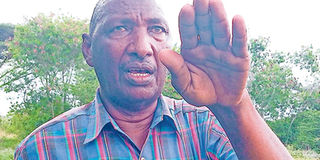Chalbi farmers beat odds to grow fodder

Kalacha Irrigation Scheme chairman Godana Sora. The scheme began with only 20 acres but has now expanded to more than 200. PHOTO | JACOB WALTER | NATION MEDIA GROUP
What you need to know:
- Kalacha scheme chairman Godana Sora says the irrigation idea was born in 1984. The farmers began with about 20 acres.
- Grass varieties grown at the scheme are Kikuyu, rhodes, star, meadow, buffalo and multipurpose leucaena and moringa trees.
- The project has been supported by the government and the African Development Bank (AfDB) under the Drought Resilience and Sustainable Livelihoods Programme (DRSLP) at Sh76.3 million.
- According to DRSLP national coordinator Haron Goro, only about 20 per cent of the total irrigation potential in northern Kenya has been realised.
On the fringes of Chalbi desert is a group of farmers that has beaten the odds to grow and supply fodder to hundreds of pastoralist families in Marsabit County.
Having tried their hand in mixed farming and failed due to the menace of pests and wild animals, the farmers resorted to fodder growing as a solution to the county’s main problems – drought and widespread poverty.
Kalacha Irrigation Scheme in Maikona, North Horr Sub-County, is an unusual project.
It bolstered livestock farming in Marsabit at a time pastoralists had almost given up due to the annual droughts and famines that wipe out thousands of cattle, camels, goats sheep, donkeys and other animals.
Kalacha scheme chairman Godana Sora says the irrigation idea was born in 1984. The farmers began with about 20 acres.
The scheme now occupies 200 acres of land. It has 315 members and directly benefits 250 households and another 1,250 families indirectly.
Sora says the main objective of the scheme was to produce fruits, vegetables, sweet potatoes and sugar cane, with the local markets being the target.
The diet in Marsabit mainly consists of meat, with vegetables being rare due to the arid nature of the county.
“Monkeys, baboons and other wild animals kept destroying the crops so we took the decision to begin producing fodder instead,” Sora told the Seeds Of Gold.
This drastically changed livestock farming in an area where locals use indigenous grass and plants to feed their animals. The group uses lined canals and a pipeline system to irrigate the grass.
Putting up the system cost Sh500,000, which was raised by Community Initiatives Facilitations and Assistance (CIFA) – a non-governmental organisation in Marsabit.
Grass varieties grown at the scheme are Kikuyu, rhodes, star, meadow, buffalo and multipurpose leucaena and moringa trees.
Sora says the group harvested 1,800 bales of hay in 2018 and sold 1,300 at Sh500 each. The remaining 500 are still in stores waiting for buyers. Kalacha Irrigation Scheme harvests fodder four times a year.
EMPOWERING LOCAL COMMUNITIES
The project has been supported by the government and the African Development Bank (AfDB) under the Drought Resilience and Sustainable Livelihoods Programme (DRSLP) at Sh76.3 million.
DRSLP coordinator Charles Muturi says the funding went towards a modern design and management system that has transformed Kalacha into a model small-scale community-run irrigation programme.
“We reorganised the scheme and set up a 15-member sub-committee that which oversees water distribution. This has made it easier to manage the scheme. The farmers are already selling fodder and making a profit,” Mr Muturi said.
Ms Adho Sharamo, a member of the irrigation scheme, expressed excitement about the rehabilitation “which has tremendously transformed our lives socially and economically”.
“Since we began growing fodder, poverty has reduced significantly in this area. Group members want to diversify from pasture production and reintroduce high value crops like Irish potatoes, sukuma wiki, spinach, carrots and cabbages,” Sharamo said.
Despite the optimism, producing the grass comes with some challenges. Kalacha Irrigation Scheme members cite poor market for commercial livestock feed during rainy seasons, lack of appropriate grass harvesting tools and lack of marketing channels.
According to DRSLP national coordinator Haron Goro, only about 20 per cent of the total irrigation potential in northern Kenya has been realised.
“The solution to abject poverty and unending bloody conflicts witnessed in Marsabit and neighbouring counties lies in empowering locals economically,” Goro said.
“This can be done through irrigation schemes such as Kalacha. They enable families to be self-reliant.”
****
Funding
Canals and plans for expansion
The scheme began with only 20 acres but has expanded to more than 200. Kalacha Irrigation Scheme chairman Godana Sora says building lined canals and a pipeline system cost about Sh500,000.
The money came from a local NGO. The efforts of the scheme have attracted the attention of the national government and the African Development Bank, who are now funding its expansion.
Members say they want to diversify from fodder to fruit production.





